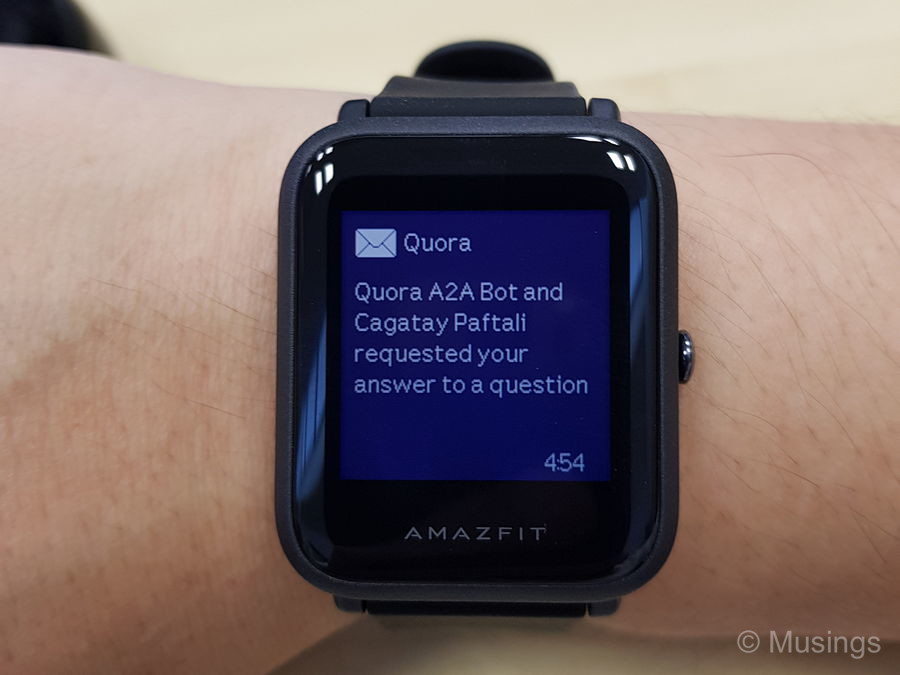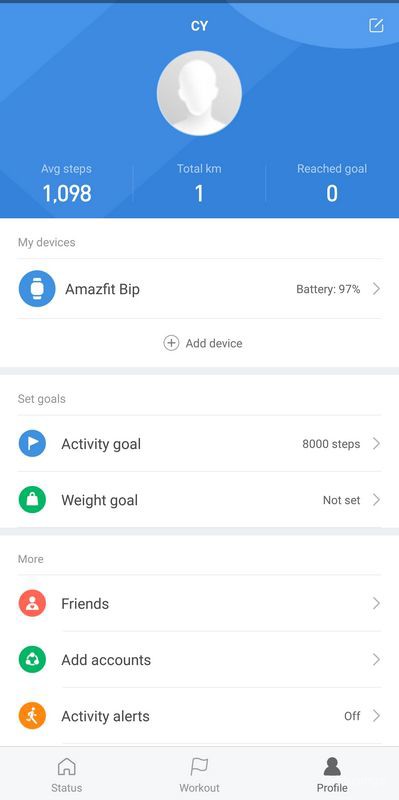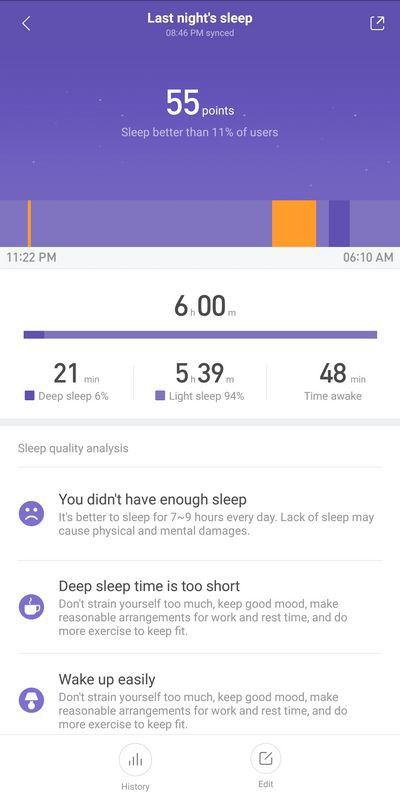Continued from the last post and covering more early impressions of the Amazfit Bip!
I prefer traditional round-face than square-face watches. But there’s one advantage of the latter on devices like the Bip or the Apple Watches: I get more detailed notifications on the Bip, since the square-face can easily fit more lines of text. Text notifications – whether from WhatsApp, SMS or email – on my last three round-face smartwatches were frequently limited to just roughly one line of text. This Bip can easily fit about five lines of text.
On the other hand, the Bip doesn’t allow you to (quick) reply to text messages you receive. The other major smart watch ecosystems permit that – you can routinely either respond with canned messages or if you’re masochistic, typing text using a tiny onscreen keyboard. But replying to notifications isn’t a feature I actually used in my three earlier watches, so no – I’m not missing this finally on the Bip.
I wrote early this year that I found the Gear Sport’s vibration alert somewhat mild and easy to miss, unless you wear the strap fairly tight around your wrist. The Bip’s notification vibration is a little stronger though thankfully still not to the point where you could get a heart attack from incoming alerts.
The touchscreen on the Bip is responsive, and swipes are immediately registered. Swiping animation between frames of information or settings isn’t fluid though, which could be important for people who care about these things. One thing that I really like about the touch screen too is that the watch is automatically locked when the backlight display auto-offs. To interact with the watch, you’ll need to unlock it by pressing the crown, which also turns the backlight on again. Quite nifty. I’ve lost count of the number of times when I unintentionally triggered a feature on the Gear Sport by accidentally brushing against the watch face! There should be someway to put the Gear Sport on lock too – not that I’ve discovered it yet though.
One oddity about the touchscreen though: it seems to register accidental touches too readily – not unlike the hypersensitive thumbprint scanner on my Huawei Mate 9 Pro from last year. The Bip’s watch face was unlocked during a morning shower, and when water from the showerhead randomly impacted the touchscreen, it sent the Bip into crazy town mode as different functions were triggered.
The Mi Fit App has quite a bit of depth and nested tabs of details, but is also plain-looking. Nothing quite like the slick looking Samsung Galaxy Wear and Health apps with its numerous visualizations showing trending. I also observed some delays in Mi Fit app receiving updated activity tracks, e.g. number of steps. The Samsung apps in comparison offer instantaneous updating.
My use case for this smartwatch is pretty basic: it’s not intended to replace my Gear Sport, but as an alternate wearable when daily charging is a big inconvenience – i.e. when I’m traveling – especially for our upcoming Taiwan trip at the end of this year – or when I’m traveling in areas where I’m likely to get robbed haha. And I don’t need GPS, round the clock heart rate tracking, or music playback on my smartwatches. My primary use of smartwatches are centered on it keeping time (which is why an all week always-on-display is a huge preference for me in this secondary watch), receiving notifications, IP68 water resistance rating so that I can keep it on when I swim, and a couple of activity tracking: specifically, steps and floors climbed. Of this, the Bip meets every use case scenario if to varying effect – excepting one: floors climbed. The Bip can’t currently track that. According to this reviewer though, the Bip does have a built-in altimeter, so this seems to be likely an app rather than hardware limitation. So, here’s hoping that this activity will be added to a future Mi Fit app version later.
The Bip uses a 190mAh Li-Polymer Battery; that’s paltry small compared to the Gear Sport’s 300mAh. But it also advertises a 30 day battery life – something that I approached with quite a bit of skepticism. I reckon you might only get that if you let the watch sit (wear?) pretty with minimal interaction. I needed the watch to run for around 14 days at least – and from the couple of days of normal and non-extreme usage i.e. no GPS, no constant fiddling with the phone etc, the Bip won’t last 30 days for me. The battery dropped between just under 3 to 6% after each full-day with my above use case,: telling time, notifications, always on display (with the backlight set on auto-off of course), and some activity tracking. About 3% when there were few notifications – e.g. off work on a weekend – and as much as 6% on a fairly busy work day with the Bip rattling away from a constant stream of vibrations from students and colleagues. So, on balance and under normal use, the Bip should run for 20 days and conservatively a fortnight still. Yeh!!! I can wear this for our 12 day Taiwan trip and leave the charger at home!



So, all-in: the Bip isn’t quite a perfect smart watch nor a full-on replacement for my Gear Sport. No, I wasn’t expecting it to be, and head-on comparison-wise, the Gear Sport wins out in a lot of areas: looks, its crazy good Amoled display screen, slick apps, premium look – but loses out to the Bip in battery longevity. The Sport manages about 1.5 days reliably compared to the at least a fortnight I can get out of this Bip. But the Bip is also, well, butt-ugly. I’ll excuse the screen display since I get the battery life, but there’s no reason why the bezels on this thing couldn’t have been smaller. Both can broadly do the same thing – activity tracking (excepting floors climbed), it’s water resistant and thus usable for swimming, and notifications with the Bip offer loads more immediate detail on a screen. What finally though makes the Bip such a good buy is its rock bottom price-point. You could buy four Bips for the price of one Gear Sport, and the latter is far from the most pricey mainstream smart watch even.
So, on account of the Bip’s low price-tag, it gets a qualified recommendation from me if you’re in one of these three use cases: if you’re looking for a smartwatch which does notifications first and activity tracking secondarily, or you’re willing to only pay peanuts, or battery life is more important than anything else in this wearable.
Recent comments